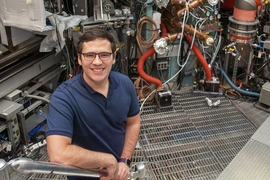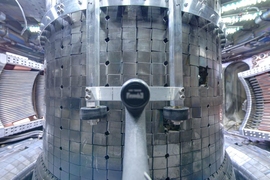Nathan Howard, research scientist at MIT’s Plasma Science and Fusion Center (PSFC), has won the 2019 Nuclear Fusion Award from the International Atomic Energy Agency (IAEA) for a paper that explains heat losses due to turbulence in the core of magnetically confined fusion plasmas.
Understanding and predicting plasma turbulence has been a key challenge for fusion researchers. Simulations of turbulent plasma conditions have not always been able to match experimental observations of heat loss in magnetically confined plasmas, making it impossible for researchers to be confident predicting the performance of future tokamaks, like ITER, the next-step fusion reactor being built in France. In collaboration with colleagues from MIT, the University of California at San Diego, and General Atomics, Howard discovered that only by performing multiscale simulations, which simultaneously capture both short wavelength (electron scale) and long wavelength (ion scale) plasma turbulence, could he match the experimental observations.
Before this, many researchers had assumed that the turbulence caused by electrons would be negligible in relation to the greater turbulence caused by ions, which is 60 times larger. In fact, this work found that the smaller-scale electron-scale turbulence interacts with the ion-scale turbulence in a way that contributes significantly to the experimental results and would need to be considered in any simulation.
The multiscale simulations took approximately 120 million CPU hours and roughly a year to run on the Edison supercomputer at the National Energy Research Scientific Computing Center (NERSC), requiring Howard to get increases from the U.S. Department of Energy to his already-large allocation. Additionally, while the NERSC system only allows jobs to run without interruption for 36 hours, Howard's simulations took months to complete, necessitating frequent restarts.
“I’d wake up in the middle of the night and basically switch jobs around so I could keep the simulation running as frequently as possible because I wanted the answer faster. They still took months and months to do.”
What most excites Howard about the research is that the multiscale results of his paper have been incorporated into a reduced transport model called Trapped Gyro-Landau Fluid (TGLF), a model that provides results in a fraction of the time of a supercomputer.
“This allows you to predict the electron temperature, electron density, ion temperature profiles that you see in the experiment, but do it in a matter of minutes, not years,” says Howard. “That’s really what was cool about this work: Not only did it show that you can match these experiments with these large-scale simulations, but the results were fed back into TGLF and created a slightly different TGLF model that is now used to predict performance and interpret results on a number of fusion devices.”
Noting that the reduced model is now being used to predict performance of the PSFC’s proposed path to fusion, SPARC, Howard says, “It’s come full circle.”
Howard continues to explore similar simulations, but is looking at higher performance discharges than before, to see if the observed multiscale interactions still exist and to gain greater insight into how and when turbulence occurs.
Inaugurated in 2006, The Nuclear Fusion Award is given annually to recognize work published in the journal Nuclear Fusion that has made the largest scientific impact. Past recipients have included other members of the PSFC community: Senior Research Scientist John Rice (2010) and Director Dennis Whyte (2013).
Howard authored the winning paper as a postdoc supported by the Oak Ridge Institute for Science and Education (ORISE), using data from the PSFC’s Alcator C-Mod tokamak. He credits co-authors Chris Holland (University of California at San Diego), and Jeff Candy (General Atomics), as well as MIT colleagues Anne White, head of the Department of Nuclear Science and Engineering, and Martin Greenwald, PSFC deputy director. He is also grateful for significant support and encouragement from program managers at the Department of Energy.
“There is support for good science wherever it goes. And I think that is one thing that is great about the PSFC. It allows you to pursue what you feel is interesting research, and let it take you in a direction that you think might be most interesting and impactful. Working here, combined with the ORISE, really allowed me to do that.”
Howard will receive the award at the IAEA Fusion Energy Conference to be held in France in 2020.
The research was supported by the U.S. Department of Energy.









